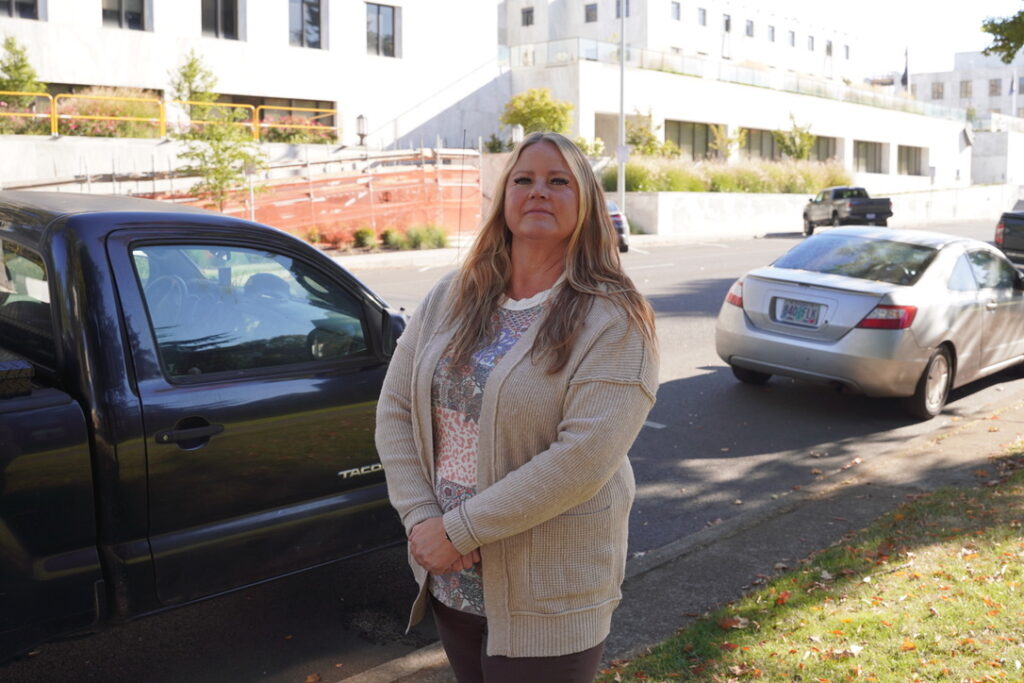Christina Sydenstricker-Brown, a caregiver in an Oregon Department of Human Services group home and president of AFSCME Local 124, stands outside the Oregon State Capitol on Sept. 30, 2024. The union, which represents about 600 group home workers, has fought to access incentive pay that the Legislature allocated. (Ben Botkin/Oregon Capital Chronicle)
Hundreds of Oregon Department of Human Services caregivers who work in state-run group homes for people with disabilities are looking for relief from heavy workloads and mandatory extra shifts that can give them 16-hour workdays.
Earlier this month, the union for caregivers in the agency’s Stabilization and Crisis Unit group homes reached a temporary 90-day agreement with the Oregon Department of Human Services that guarantees staffers will receive extra incentive pay when they work extra shifts. The extra pay, already offered in a previous agreement and based on $3.4 million appropriated by lawmakers, did not flow to workers as they expected.
To reach that point, the union had prodded the agency’s management for months. The union also informed DHS Director Fariborz Pakseresht their membership planned to take a vote of no-confidence in his leadership of their unit, which has nearly 600 workers who serve 83 clients in 20 group homes. The clients, who usually have no place else to live, have developmental or intellectual disabilities, sometimes combined with mental health conditions.
For now, the union has paused the vote planned for October as both sides look toward a solution to extend beyond the temporary agreement, which ends on Jan. 5, 2025. And union leaders say a future vote is not off the table if workers continue to be stretched thin, often in environments that are unsafe or stressful. Though the vote is largely symbolic, the plans to hold one underscore the frustrations of workers and their low morale as they care for Oregon’s most vulnerable people.
“There’s nothing more for us to give,” said Christina Sydenstricker-Brown, a caregiver and president of AFSCME Local 124, which represents the workers. “And we’re exhausted. Our bodies are tired, and our individuals are the ones that are suffering from this, our children at home and our spouses and our loved ones. In a nutshell, it’s just like you feel stuck; you feel trapped.”
In an interview with the Capital Chronicle, Pakseresht said he’s committed to a solution and working with union officials.
“From my perspective, labor is the most critical part of the work that we do, because without them, the work doesn’t happen,” he said.
He said the “last thing” DHS wants is to further burden the lives of people who work so much that they can’t spend time with their families.
Incentive money unused
The temporary 90-day agreement changes a previous agreement between the union and state that started in September 2023.
That agreement gave workers incentive pay of up to $18 an hour when they volunteer for extra shifts. That’s on top of their base pay, which can start as low as about $22 an hour. People mandated to work extra shifts without volunteering get $10 an hour extra. The goal was to encourage people to sign up so that fewer employees would face mandatory overtime.
But that pay came with a catch that quickly became a dispute. In order for the incentive pay to flow, the unit needed a vacancy rate of 10.5%. Agency managers and workers had two differing interpretations of how to apply that requirement.
The union says the vacancy rate should include vacancies due to unfilled positions and employees who are out on leave for different reasons, like injuries, illness, pregnancies and family leave.
DHS managers believe the agreement only allowed a strict interpretation of the “actual vacancy rate,” regardless of whether employees were actually working shifts or on leave. An agency spokesperson, Jake Sunderland, pointed to the original agreement, which states: “Actual vacancy rate means vacant budgeted positions that SACU has authority to fill.”
Under the agency’s interpretation, workers rarely received incentive pay because the vacancy rate remained below the 10.5% threshold.
By early October, there was only one pay cycle in the first year of the agreement that qualified for incentive pay. As of September 24, 2024, the unit had 22 vacant budgeted positions, which is a vacancy rate of 3.72%, the agency said.
Pakseresht said he was bound by the terms of the letter of agreement. In a “fairly emotional meeting” with union leaders, he said he told them that “health and safety” are important.
The new agreement, amended Oct. 5, temporarily removes the vacancy requirement and gives both sides time to hash out a long-term agreement.
Pakseresht said that the agency is planning to do an in-depth analysis that looks at why people are on leave or missing work when the vacancy rate is relatively low.
“What are some of those factors?” he said. “What are some of the root causes that are contributing to that? So I think that’s information that we need to have naturally.”
Union leaders say the process should not have taken as long as it did and they’re eager to reach a long-term solution. Public records show they asked agency leaders to address the lack of incentive pay before the Oct. 5 temporary agreement came together.
“Why would DHS not agree to this if the Legislature gave you the funding specifically for this?” Jade McCredy, state program manager for Oregon AFSCME Council 75, wrote in a Sept. 4 email to Pakseresht and the agency’s human resources director.
For now, union leaders are hopeful for a permanent solution – but willing to put a vote to workers about the agency’s leadership if progress stalls.
“Right now we’re just at a pause and we’re just waiting to see what happens,” Sydenstricker-Brown said.
GET THE MORNING HEADLINES.

